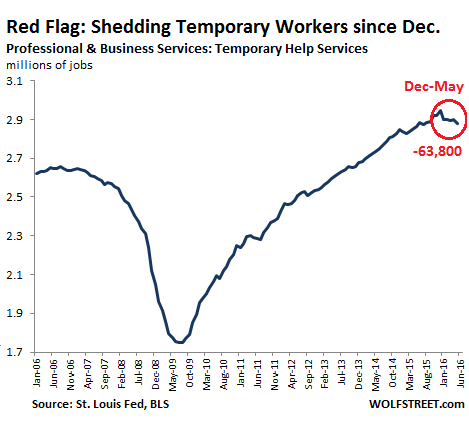The 90% know they’ve gotten the short end of the stick for way too long. Now, with the bad May jobs report that came out last Friday, there is concern that our seven-year recovery, which has not helped everyone, may not last a lot longer.
So, a quick review of the numbers: The BLS reported that the economy had added 38,000 jobs in May, the lowest since September, 2010. Furthermore, the April job gains of 160,000 were cut by 37,000, while the March job gains of 208,000 were cut by 22,000.
So, with 59,000 jobs revised away, and with only 38,000 jobs “created” in May, the net total in today’s report was a net loss of 21,000 jobs in the last 3 months. We haven’t seen this since the 2008 Financial Crisis. And the labor participation rate dropped for the second month in a row, to 62.6%, which doesn’t bode well for the future either.
But the true bad news was that the number of temporary jobs also fell by 21,000. Temporary employment is a predictor of future employment trends, both on the way up, and on the way down.
The temporary-help sector has been the best thing about the economy; we reported in March that more than 100% of the jobs created in the US since 2005 were temp or contracting jobs. The temporary jobs sector peaked in December 2015 at 2.94 million, and has lost 63,800 jobs since then:

Wolf Richter thinks that the decline in temporary workers isn’t just a one-month statistical blip, but a five-month trend, and that the sector has become a warning sign that the labor market could be heading towards deeper trouble. From Richter:
This also happened in 2007, when the temporary help sector started shedding jobs even as the overall economy was still adding jobs until right up to the official beginning of the Great Recession. And it happened in 2000, before the 2001 recession kicked in.
We lost nearly 8 million jobs in the Great Recession. Since 2009, the economy has added 14.5 million new jobs. But if we subtract the 8 million jobs lost during the recession, our net job growth was 6 million added, while our population grew by 16.5 million.
Now, not all of the growth in population is a person currently looking for a job. The big contributors are immigrants (both legal and otherwise), and births. Most of the immigrants want work, but they are the smaller fraction of our population growth, while infants, toddlers, and young children do not need access to employment just yet. The Boomers are trying to stay employed and not retire, while Millennials have moved into the workforce.
All of these groups are jostling for jobs. If US job growth can’t accommodate them, their individual situations will get worse, even while the overall numbers might look acceptable on paper.
So the questions for the Pant Suit and the Pant Load are:
- Do they think that the lack of GDP growth and our lack of jobs growth is politically sustainable? How long could it go on without seeing pitchforks in the streets?
- Where are the jobs going to come from?
- What will they do if the jobs fail to materialize?
Hillary Clinton has the bigger problem, since she is presenting herself as the heir of Obama’s (and earlier, Bill Clinton’s) economic policies. She has to play defense on the economy. Trump can jump on the bad data, saying he can fix it, and many people will accept that uncritically.
But don’t count on hearing either candidate say anything that you think is useful. They will look for, and fail to find, “market” solutions to this dilemma created by the “market.”
And market solutions are what they will tell us we must wait for.

It is hard to imagine where jobs would come from. The sensible thing would be infrasctructure, but Republicans won’t do that anymore. And forget about innovation. Innovation reduces jobs.